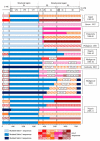Recombination in Enteroviruses, a Multi-Step Modular Evolutionary Process
- PMID: 31540135
- PMCID: PMC6784155
- DOI: 10.3390/v11090859
Recombination in Enteroviruses, a Multi-Step Modular Evolutionary Process
Abstract
RNA recombination is a major driving force in the evolution and genetic architecture shaping of enteroviruses. In particular, intertypic recombination is implicated in the emergence of most pathogenic circulating vaccine-derived polioviruses, which have caused numerous outbreaks of paralytic poliomyelitis worldwide. Recent experimental studies that relied on recombination cellular systems mimicking natural genetic exchanges between enteroviruses provided new insights into the molecular mechanisms of enterovirus recombination and enabled to define a new model of genetic plasticity for enteroviruses. Homologous intertypic recombinant enteroviruses that were observed in nature would be the final products of a multi-step process, during which precursor nonhomologous recombinant genomes are generated through an initial inter-genomic RNA recombination event and can then evolve into a diversity of fitter homologous recombinant genomes over subsequent intra-genomic rearrangements. Moreover, these experimental studies demonstrated that the enterovirus genome could be defined as a combination of genomic modules that can be preferentially exchanged through recombination, and enabled defining the boundaries of these recombination modules. These results provided the first experimental evidence supporting the theoretical model of enterovirus modular evolution previously elaborated from phylogenetic studies of circulating enterovirus strains. This review summarizes our current knowledge regarding the mechanisms of recombination in enteroviruses and presents a new evolutionary process that may apply to other RNA viruses.
Keywords: RNA virus; emergence; enterovirus; recombination; viral evolution.
Conflict of interest statement
The authors declare no conflict of interest.
Figures







Similar articles
-
Nonhomologous recombination between defective poliovirus and coxsackievirus genomes suggests a new model of genetic plasticity for picornaviruses.mBio. 2014 Aug 5;5(4):e01119-14. doi: 10.1128/mBio.01119-14. mBio. 2014. PMID: 25096874 Free PMC article.
-
Recombination between poliovirus and coxsackie A viruses of species C: a model of viral genetic plasticity and emergence.Viruses. 2011 Aug;3(8):1460-84. doi: 10.3390/v3081460. Epub 2011 Aug 17. Viruses. 2011. PMID: 21994791 Free PMC article. Review.
-
Recombination Analysis of Non-Poliovirus Members of the Enterovirus C Species; Restriction of Recombination Events to Members of the Same 3DPol Cluster.Viruses. 2020 Jun 30;12(7):706. doi: 10.3390/v12070706. Viruses. 2020. PMID: 32629843 Free PMC article.
-
High Permissiveness for Genetic Exchanges between Enteroviruses of Species A, including Enterovirus 71, Favors Evolution through Intertypic Recombination in Madagascar.J Virol. 2019 Mar 5;93(6):e01667-18. doi: 10.1128/JVI.01667-18. Print 2019 Mar 15. J Virol. 2019. PMID: 30602612 Free PMC article.
-
[A role of recombination in the evolution of enteroviruses].Vopr Virusol. 2005 May-Jun;50(3):46-52. Vopr Virusol. 2005. PMID: 16078434 Review. Russian.
Cited by
-
Evolutionary and Genetic Recombination Analyses of Coxsackievirus A6 Variants Associated with Hand, Foot, and Mouth Disease Outbreaks in Thailand between 2019 and 2022.Viruses. 2022 Dec 27;15(1):73. doi: 10.3390/v15010073. Viruses. 2022. PMID: 36680113 Free PMC article.
-
Molecular Epidemiology Reveals the Co-Circulation of Two Genotypes of Coxsackievirus B5 in China.Viruses. 2022 Nov 30;14(12):2693. doi: 10.3390/v14122693. Viruses. 2022. PMID: 36560696 Free PMC article.
-
Viral Replicon Systems and Their Biosafety Aspects.Appl Biosaf. 2023 Jun 1;28(2):102-122. doi: 10.1089/apb.2022.0037. Epub 2023 Jun 5. Appl Biosaf. 2023. PMID: 37342518 Free PMC article. Review.
-
Diversity of Human Enterovirus Co-Circulations in Five Kindergartens in Bangkok between July 2019 and January 2020.Viruses. 2023 Jun 20;15(6):1397. doi: 10.3390/v15061397. Viruses. 2023. PMID: 37376696 Free PMC article.
-
Enhanced echovirus 11 genomic surveillance in neonatal infections in Spain following a European alert reveals new recombinant forms linked to severe cases, 2019 to 2023.Euro Surveill. 2024 Oct;29(44):2400221. doi: 10.2807/1560-7917.ES.2024.29.44.2400221. Euro Surveill. 2024. PMID: 39484685 Free PMC article.
References
-
- Pallansch M., Roos R. Enteroviruses: Polioviruses, coxsackieviruses, echoviruses, and newer enteroviruses. In: Knipe D.M., Howley P.M., editors. Fields Virology. Lippincott Williams and Wilkins; Philadelphia, PA, USA: 2007. pp. 839–893.
-
- Yang T.-T., Huang L.-M., Lu C.-Y., Kao C.-L., Lee W.-T., Lee P.-I., Chen C.-M., Huang F.-Y., Lee C.-Y., Chang L.-Y. Clinical features and factors of unfavorable outcomes for non-polio enterovirus infection of the central nervous system in northern Taiwan, 1994–2003. J. Microbiol. Immunol. Infect. 2005;38:417–424. - PubMed
Publication types
MeSH terms
LinkOut - more resources
Full Text Sources

